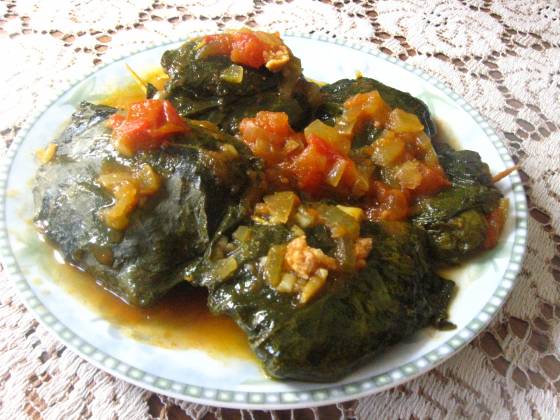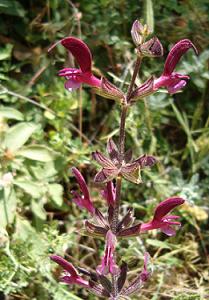 This edible leaf is shooting up all over the Middle East right now. Ask for marmia in Arab markets.
This edible leaf is shooting up all over the Middle East right now. Ask for marmia in Arab markets.
To celebrate the emergence of winter’s wild greens, here is a vegan recipe featuring a Middle Eastern specialty: Jerusalem Sage.

Jerusalem sage
Wild, edible Salvia hierosolymitana has dark-pink or reddish flowers and is not the same as the decorative garden plant, Phlomis fruticosa. Both are called Jerusalem Sage in English, but the yellow-flowering Phlomis fruticosa isn’t eaten. To see the edible Middle Eastern Jerusalem Sage in flower, the one which can be eater, see the photo below.
The leaf may be chopped and added to soups or stews as a pot herb, but the most delicious way to eat it is stuffed with rice and vegetables, enriched with a tomato sauce. If Jerusalem Sage isn’t available, you may substitute mallows, found in fields with ethical foraging – or Swiss chard, if convenient.
Find Jerusalem sage in Cyprus, Israel, Jordan, Lebanon, Syria, and the West Bank. It typically grows in open fields, rocky soils, and among low-growing native shrubs. It was first described in 1853 by botanist Pierre Edmond Boissier, with the epithet “hierosolymitana” referring to “royal, sacred Jerusalem”.

 Stuffed Jerusalem Sage Recipe
Stuffed Jerusalem Sage Recipe
Ingredients:
500 grams – 1 Ib. fresh Jerusalem Sage leaves
1 1/2 cup rice
1/2 cup pine nuts
1/4 cup olive oil
1/2 green bell pepper, finely chopped
1/2 cup onions, finely chopped
1 cup seeded, chopped tomatoes
1/2 cup chopped parsley
1 1/2 teaspoon salt
1/2 teaspoon black pepper
Another 1/4 cup olive oil
1/2 cup lemon juice
1/2 cup water and more if needed
1 large tomato, thickly sliced
Cloves from 1 head of garlic, separated and peeled
Rinse the rice and set it to drain. Blanch the leaves by placing each in boiling water for 30 seconds, then putting into a bowl with cold water.
Mix the rice and pine nuts in a medium bowl. Heat 1/4 cup olive oil in a frying pan and cook the bell pepper, onions, parsley and chopped tomatoes in it over medium heat for 5 minutes, stirring a few times. Season with salt and pepper to taste. When the vegetables are softened, reserve 3 tablespoons and set aside. Pour the rest into the rice/pine nuts mixture. Mix well.
Spoon one tablespoon of filling onto the center of each leaf and make a square bundle, securing it with a toothpick. Alternately, place the filling on the broad end of the leaf and roll it into a fat cigar. Secure with a toothpick.
Pour 1/4 cup olive oil into a large pot. Cover the bottom of the pot with sliced tomato and peeled garlic cloves. Place the stuffed leaves on top, making layers if needed. Sprinkle salt and lemon juice over all; add water to barely cover the leaves. Scatter the reserved cooked vegetables over the top. Bring to a simmer then cook, covered, over low heat 1/2 hour or until sauce thickens. Check once or twice to make sure the bottom layer isn’t drying out or scorching.
Serve hot.
Enjoy!
More wild recipes on Green Prophet:
- 3 Wild Edibles and How to Eat Them
- Go Wild with Weeds in Two Winter Salads
- The Best Baba Ganoush Starts with a Wild Eggplant




